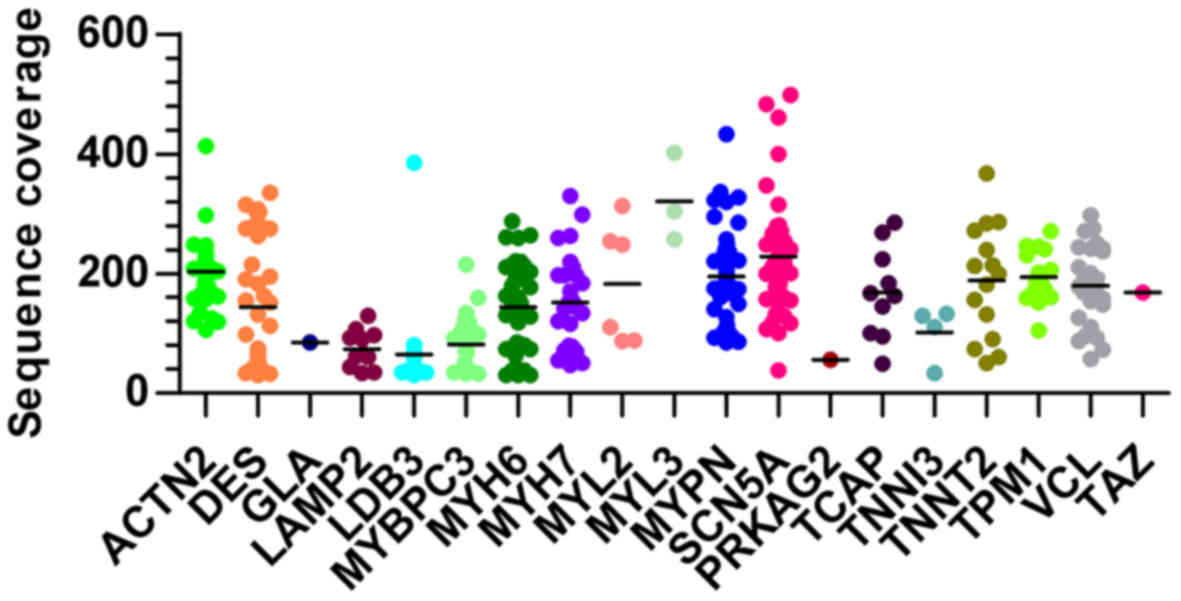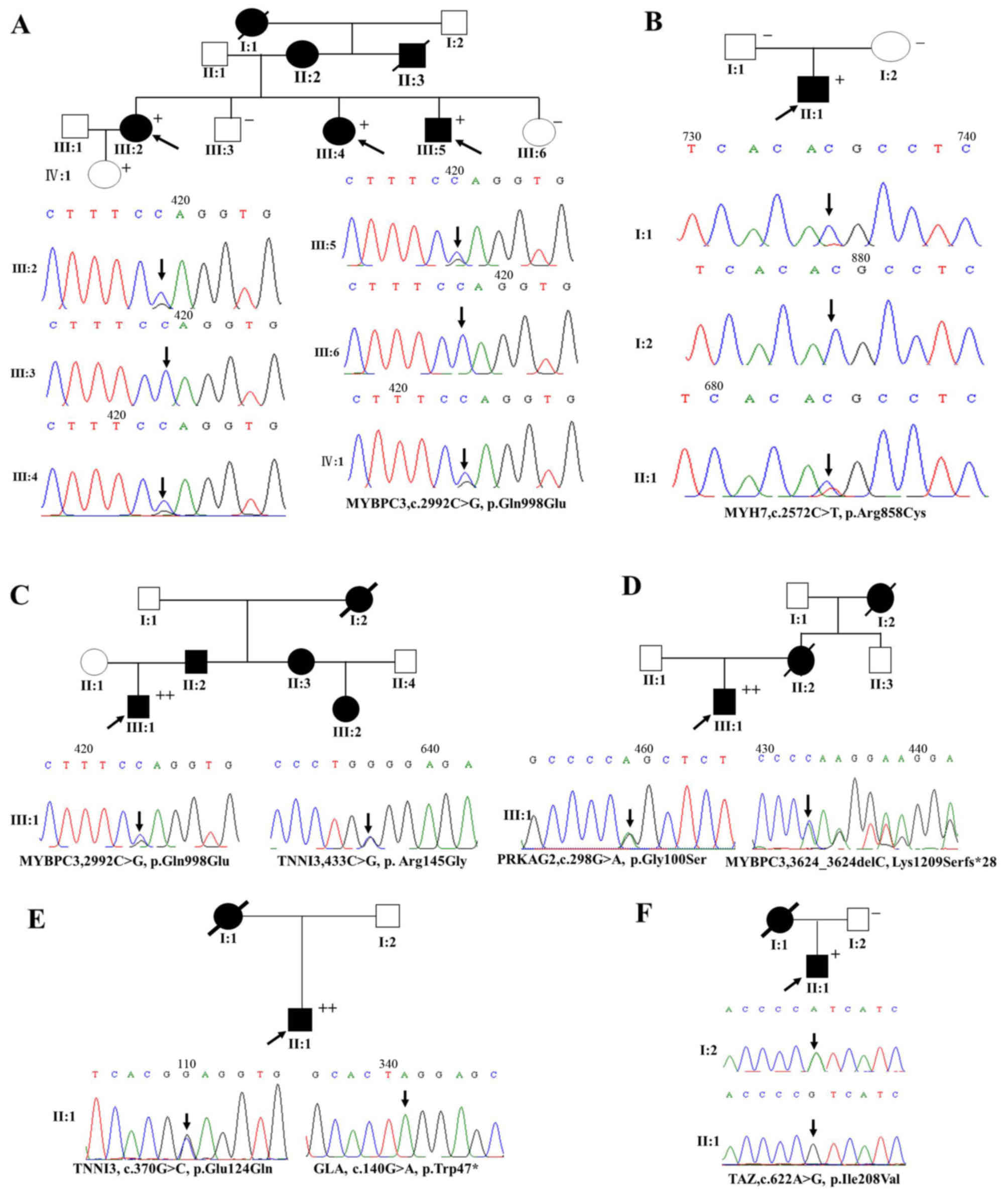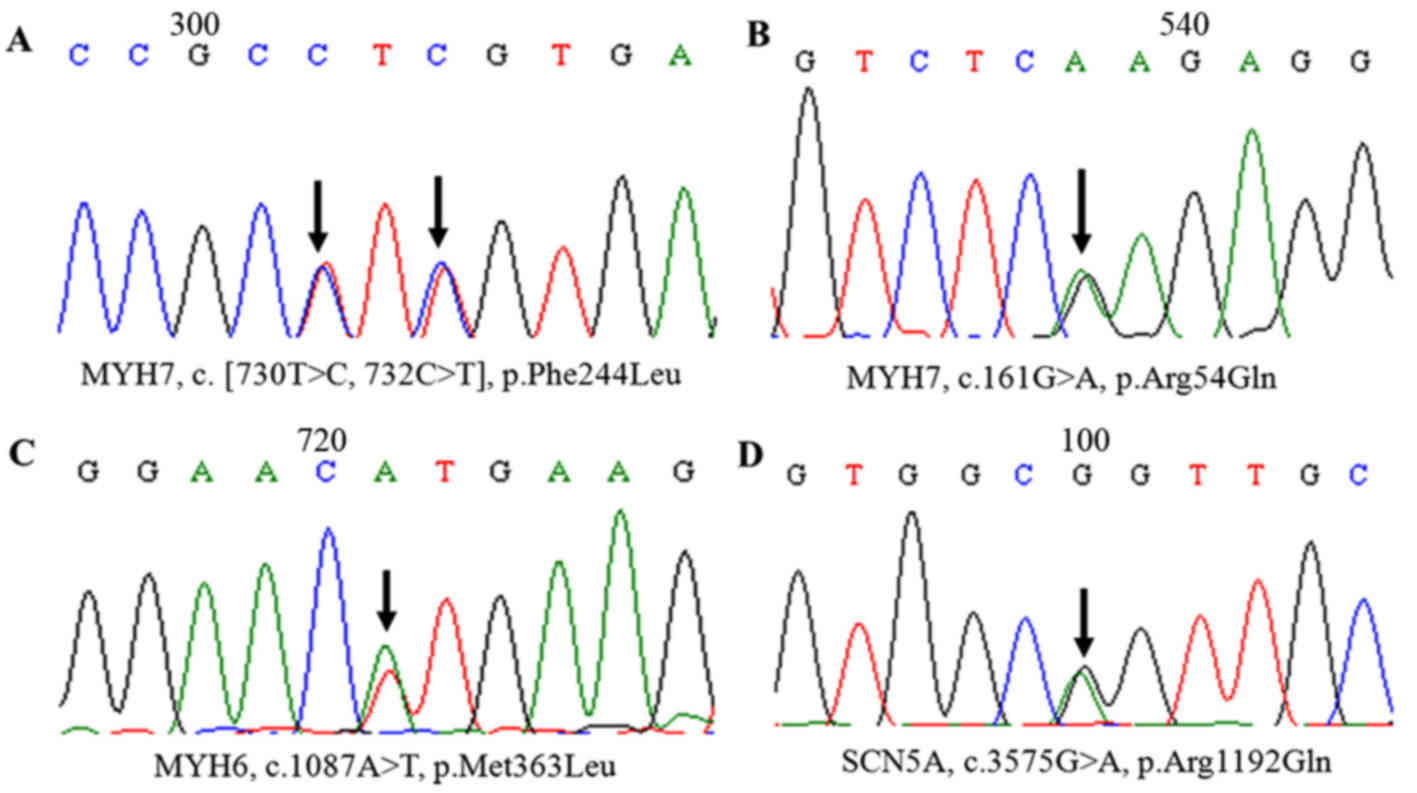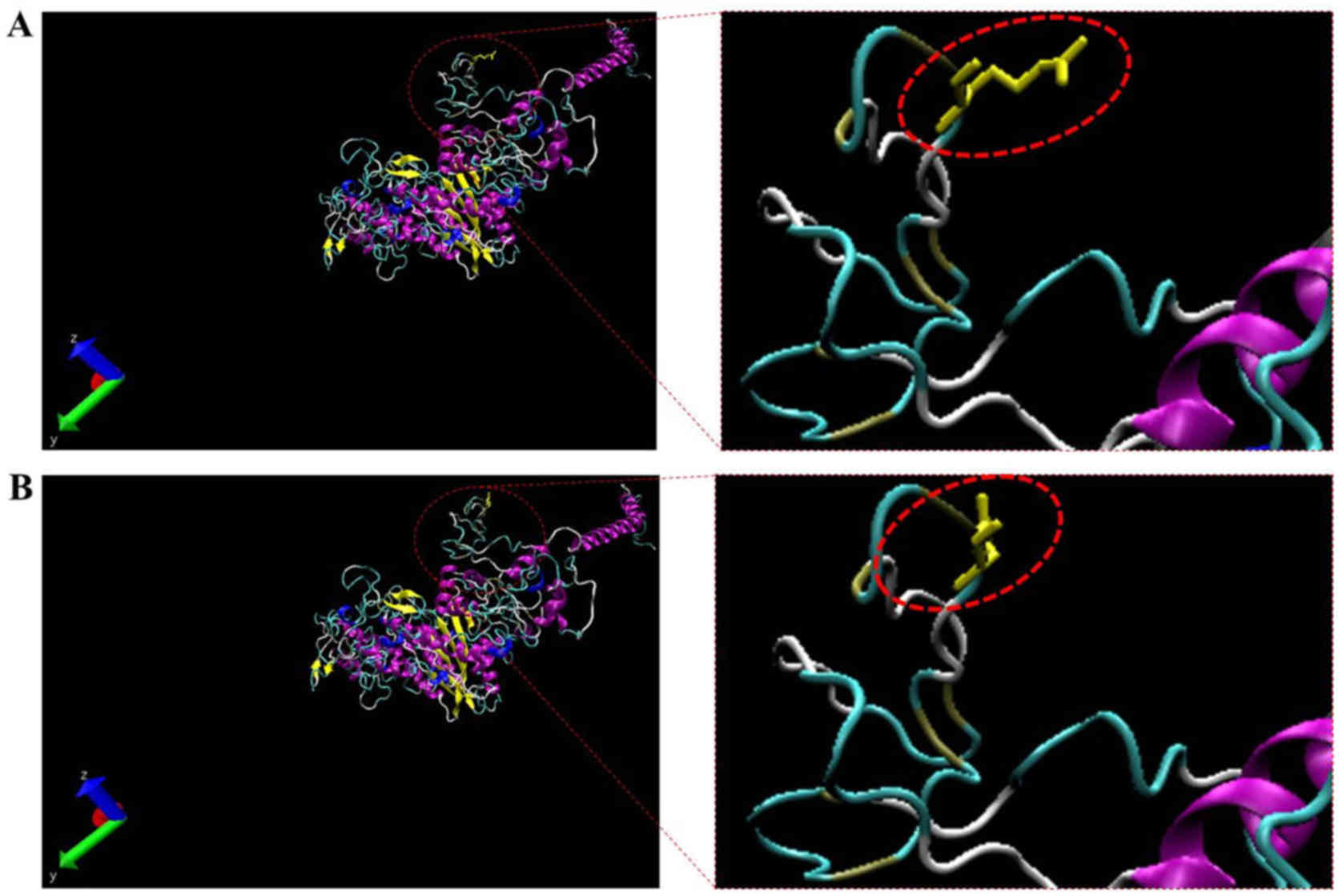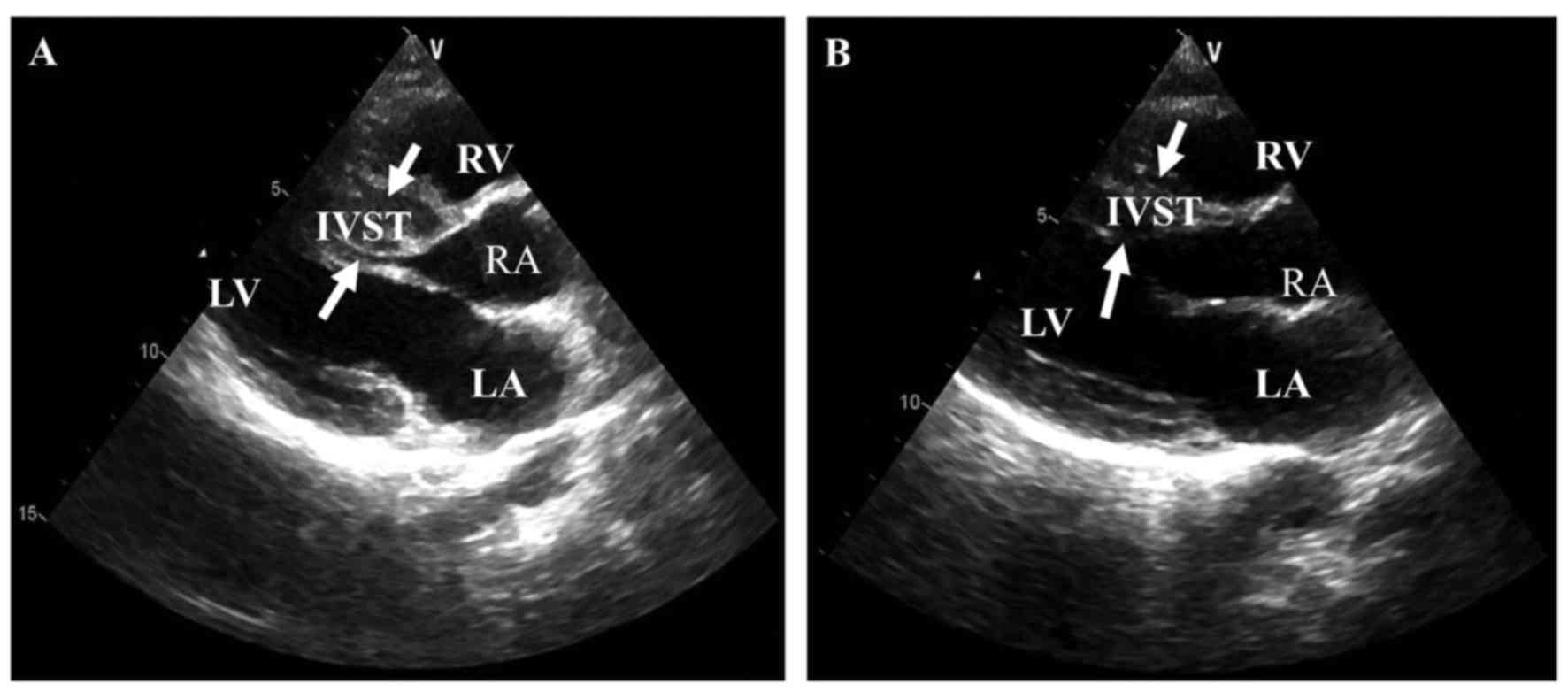Identification of a novel hypertrophic cardiomyopathy-associated mutation using targeted next-generation sequencing
- Authors:
- Published online on: May 11, 2017 https://doi.org/10.3892/ijmm.2017.2986
- Pages: 121-129
-
Copyright: © Zhao et al. This is an open access article distributed under the terms of Creative Commons Attribution License.
Abstract
Introduction
Hypertrophic cardiomyopathy (HCM: OMIM 192600) is one of the most common inherited cardiac diseases characterized by marked thickening of the left ventricle or/and interventricular septum. HCM may affect groups of all ages and ethnicity, with an incidence of 1 in 500 individuals in the general population worldwide (1). In China, at least one million individuals are expected to be diagnosed with this disease (2). It has been considered as the major cause of sudden cardiac death in young adults and competitive athletes. Most HCM patients experience obvious clinical symptoms, including shortness of breath, palpitations, angina and syncope. However, HCM also presents with high variability in clinical presentation due to the genetic heterogeneity of the patients. It is predominantly inherited in an autosomal dominant pattern, but fewer HCM patients present with X-linked inheritance or Mendelian autosomal recessive disease. The first mutation highly associated with HCM was discovered in the β-myosin heavy chain gene (MYH7) in 1990 (3). To date, over 1,400 responsible mutations have been documented in more than 25 genes (4,5). Genetic testing can provide more accurate information for clinical diagnosis, especially for those ambiguous HCM cases, and for evaluation of the risk of disease occurrence of individuals with familial HCM (6).
Compared to the traditional genetic testing method, Sanger sequencing, which is costly and time-consuming, recently developed next-generation sequencing (NGS) technologies can improve cost effectiveness. NGS is highly feasible for massive parallel sequencing and is suitable for inherited disease testing (7–9), including cardiomyopathies (10–12). Yunnan Province, located in southwestern China, consists of diverse ethnic groups (13). However, the genetic characterizations of HCM in this region have been poorly studied (14,15). In the present study, we used NGS technology to perform genetic screening of the entire exon sequence and the flanking regions of 19 most common HCM causative genes in a Yunnan population. One novel mutation in tafazzin (TAZ, p.Ile208Vla), a single rare mutation in MYH7 (p.Arg54Gln), and three double mutations responsible for HCM were respectively detected in our HCM patients. The prevalence and spectrum of gene mutations associated with HCM in Yunnan were systematically described.
Materials and methods
Subjects and clinical evaluation
From September 2013 to December 2015, 18 patients with HCM, including 8 cases from 6 pedigrees with familial HCM and 10 cases without familial HCM, and 100 healthy controls were recruited at the Department of Cardiology, The First People's Hospital of Yunnan Province. Written informed consent was obtained from all subjects. The demographic data including age, gender, and history of cardiovascular diseases and other familial diseases were recorded simultaneously with sample collection. According to the 2011 American College of Cardiology Foundation (ACCF) and the American Heart Association (AHA) guideline for the diagnosis of HCM (16), a left ventricular septum (LVS) or/and interventricular septal thickness (IVST) ≥15 mm in the absence of any other condition that could explain the hypertrophy was diagnosed as HCM. This research project was approved by the Ethics Committee of the First People's Hospital of Yunnan Province, and performed in compliance with the principles of the Declaration of Helsinki.
DNA isolation and sequencing
Genomic DNA was isolated from the peripheral whole blood of 18 HCM patients and 100 healthy controls using a genomic DNA Miniprep kit (AxyPrep; Axygen, Union City, CA, USA) following the manufacturer's protocol. OD260/280 of DNA samples was ~1.8 after purification with AMPure XP reagents (Beckman Coulter, Fullerton, CA, USA). The DNA concentration was measured using the Qubit dsDNA HS assay kit (Life Technologies, Carlsbad, CA, USA). Whole coding exons and in exon-intron boundaries of 19 HCM-related genes were amplified and then sequenced on Ion Torrent PGM (Life Technologies). These genes were MYH7, myosin binding protein C (MYBPC3), α-actinin 2 (ACTN2), desmin (DES), α-galactosidase A (GLA), lysosome-associated membrane protein 2 (LAMP2), LIM domain-binding 3 (LDB3), α-myosin heavy chain (MYH6), regulatory myosine light chain 2 (MYL2), regulatory myosine light chain 3 (MYL3), TAZ, myopalladin (MYPN), AMP-activated protein kinase (PRKAG2), sodium channel, voltage-gated type V α-subunit (SCN5A), Titin-cap (TCAP), troponin I 3 (TNNI3), troponin T 2 (TNNT2), α-tropomyosin 1 (TPM1), and vinculin (VCL).
Molecular genetic analysis
Low quality reads of which the read depth was less than 30× were discarded (17,18), and qualified sequences were mapped to human reference genome (hg19). The variants of the 19 genes in each sample were annotated using online software Ion Reporter (https://ionreporter.lifetechnologies.com/ir/secure/home.html). The missense variant was considered to be possibly related with HCM on the basis of the following criteria (19,20): i) the variant has been reported as an HCM-related mutation according to the documents or Human Gene Mutation Database (HGMD, http://www.hgmd.cf.ac.uk/ac/index.php), and/or ii) the predicted amino acid showed a change in a highly conserved evolution site across many species; iii) the missense variant was absent in the 100 healthy controls and its minor allele frequency (MAF) was <5% in the 1000 Genomes Project (http://www.1000genomes.org/), HapMap (http://hapmap.ncbi.nlm.nih.gov/) and/or Exome Aggregation Consortium (ExAC) databases (http://exac.broadinstitute.org/); iv) it was predicted as a disease-related mutation by Mutation Taster (21).
All mutations potentially related with HCM were further confirmed by conventional dideoxy sequencing using the BigDye Terminator v.3.1 Cycle Sequencing kit (Applied Biosystems, Foster City, CA, USA), and the obtained sequences were analyzed using ABI 3130 Genetic Analyzer (Life Technologies). Specific primers were applied to amplify the fragments of genomic DNA containing identified candidate variations (Table II).
Evolutionary conservation analysis of the rare and novel mutations, which were performed in many species (including Macaca mulatta, Mus musculus, Danio rerio, Drosophila melanogaster, Xenopus tropicalis, Bos taurus and Loxodonta), was conducted using Clustal W (http://www.genome.jp/tools/clustalw/) and the Weblogo (http://weblogo.berkeley.edu/logo.cgi) (15). Based on the lowest energy theory, the structure of the proteins with a rare mutation found in this study was predicted by using Robetta (http://robetta.bakerlab.org/) and SWISS-MODEL (http://www.swissmodel.expasy.org/) online program, and the result was visualized using the Visual Molecular Dynamics (VMD) software package (version 1.9.2, http://www.ks.uiuc.edu/Research/vmd/index.html).
Results
Demographic and clinical characteristics
From September 2013 to December 2015, a total of 18 HCM patients were recruited, including 11 (61%) males and 7 (39%) females. Among these, 8 patients were from 6 pedigrees with familial HCM, and the remaining 10 patients did not have familial HCM. Their mean age at diagnosis was 45 years (range 23–79) with a standard deviation (SD) of 16 years. The detailed demographic and clinical characteristics of the patients are shown in Table I. All the investigated patients presented typical clinical manifestations of HCM. The mean left ventricular ejection fraction (LVEF) was increased to 67.1% (SD=9.9), and the IVST was 18.8±2.7 mm, the left ventricular septum thickness (LVST) was 26.3±9.7 mm, and the median left ventricular posterior wall (LVPWT) was 11.7±1.9 mm as measured by doppler echocardiography.
Sequence alignment and annotation analysis
Exons and in exon-intron boundaries of 19 HCM-related genes were sequenced using Ion Torrent PGM (Life Technologies). There were 383 variants obtained from qualified reads, with single nucleotide polymorphisms, insertions or/and deletions. The mean depth of coverage over all missense variants was 165.4-fold (ranged from 30 to 498) as shown in Fig. 1. Those variants were annotated and the synonymous variants were filtered out using Ion Reporter online software (https://ionre-porter.lifetechnologies.com/ir/secure/home.html). As a result, 86 non-synonymous variants were detected in the 18 HCM patients (data available upon request).
Screening for variants with higher potential association with HCM
We next focused on the variants which were potentially related with HCM. Based on the potentially pathogenic criteria (mentioned in Materials and methods), 12 mutations were selected from 13 HCM patients and further confirmed by Sanger sequencing (Table II). There were 6 single mutations and 3 double mutations which were most frequently found in MYBPC3 and MYH7 with a prevalence of 38.5% (5/13) and 23.1% (3/13), respectively. Other variants, including TNNI3, SCN5A, GLA, TAZ, PRKAG2 and MYH6, were found in 53.8% (7/13) of the patients (Figs. 2 and 4). One novel single mutation in TAZ (p.Ile208Val) was found neither in the 1000 Genomes Project databases (http://www.1000genomes.org/) nor in the 100 healthy control chromosomes. One reported single mutation in MYH7 (p.Arg54Gln), considered as rare in the general population, was firstly found in a patient without familial HCM and did not exist in the databases and the control group mentioned above. The mutations identified in highly conserved amino acids among many species may have influenced the structure and function of the proteins (Fig. 5). Therefore, the predicted protein structure of a mutant MYH7 (p.Arg54Gln) was compared to the corresponding wild-type. The homology modeling analysis showed that the amino acid change resulted in the structural differences between the wild-type and mutant MYH7 (Figs. 5 and 6). In addition, the 3 double mutations were found in MYBPC3 (p.Gln998Glu) plus TNNI3 (p.Arg145Gly), PRKAG2 (p.Gly100Ser) plus MYBPC3 (p.Lys1209Serfs*28), and TNNI3 (p.Glu124Gln) plus GLA (p.Trp47*) (Table III and Fig. 2).
Mutations and phenotypes of patients with familial HCM
Family A, B and F were of the Han ethnic group; family C, D and E were of the Yi, Naxi and Pumi ethnic groups, respectively. Our results showed that 3 single mutations and 3 double mutations were found in 6 pedigrees with familial HCM (Fig. 2). A 28-year-old male HCM patient, experiencing palpitation and chest tightness, was found to carry a novel mutation (TAZ, p.Ile208Val). A mutation of p.Gln998Glu in MYBPC3 was detected in a proband patient (family A, III:5) who was diagnosed as having HCM at age 34, with intermittent chest tightness and shortness of breath, and a typical thick IVST (22 mm). His 2-year-older sisters were respectively diagnosed as HCM patients at age 36 and 42 years, and his father and grandmother had undergone sudden death. Another proband (family B, II:1) having MYH7 p.Arg858Cys was diagnosed as HCM at age 23 years and experienced chest pain, but his father and mother did not have disease phenotype. More importantly, the third proband (family C, III:1) carrying a double mutation (MYBPC3, p.Gln998Glu plus TNNI3, p.Arg145Gly) had a greater IVST (18.8; >15 mm), and his father, aunt and female cousin were diagnosed with HCM a fewer years ago. A proband (family D, III:1) carrying a double mutation (PRKAG2, p.Gly100Ser plus MYBPC3, p.Lys1209Serfs*28) was diagnosed with HCM at age 26, and his mother and grandmother had undergone sudden cardiac death. A proband (family E, II:1) carrying a double mutation (TNNI3, p.Glu124Gln plus GLA, p.Trp47*) presented with heart failure at age 47 years, and the echocardiography showed that he had a high IVST (Figs. 2 and 3A).
Discussion
In the present study, we described the molecular characterization of 18 HCM patients in Yunnan Province via targeted NGS technology. A total of 383 variants were identified with an average read depth of 165.4-fold (Fig. 1). Generally, a read of a targeted nucleotide with read depth ≥30× reads was considered as qualified (17,18). By filtering out synonymous variations of the targeted genes, 86 qualified non-synonymous variations were obtained (data available upon request). This indicated the feasibility of NGS for genetic testing of 19 HCM-targeted genes.
There were 12 mutations identified in 13 HCM patients (Table III). The overall genetic diagnostic rate was 72.2% (13/18) and the frequency of disease-causing mutations in the HCM cohort were much higher than previous documentations (22–24), including an American cohort (54.2%), French cohort (60.6%) and Japanese cohort (67%) (25–27). Mutations in the MYBPC3 gene were the most prevalent that were detected in 5 of the 13 patients (38.5%). It has been reported that mutations in the MYBPC3 gene are present in close to 20–30% of HCM cases (4,20,28), and our results were consistent with these previous studies. The second most prevalent mutations were found in MYH7 in 3 patients (3/13, 23.1%), which were followed by mutations in TNNI3 (15.4%). The respective mutation rate of SCN5A, PRKAG2, MYH6, TAZ and GLA genes was close to 7.7%.
It is noteworthy that two single mutations were found for the first time in HCM patients. One in TAZ (p.Ile208Val) was novel and was found in a familial HCM male patient of 28 years. The other single mutation was in MYH7 (p.Arg54Gln), which has been rarely reported in the general population but had not been previously found in HCM patients. This mutation had a very low minor allele frequency (1/60,659) in ExAC browser Beta database (http://exac.broadinstitute.org/). Both TAZ (p.Ile208Val) and MYH7 (p.Arg54Gln) mutations resulted in polarity changes in the altered amino acids and these 2 mutations were not detected in 200 normal chromosomes. It has been speculated that these mutations may have a significant impact on the structure and function of the corresponding proteins. Indeed, the homology modeling analysis showed that, compared to wild-type MYH7, the structure of mutant MYH7 was altered at the mutated site. More detailed data are needed to detect whether these mutations influence the pathogenicity of HCM.
In the 6 pedigrees with familial HCM, 3 of them (50%) were found to carry double mutations, which were firstly discovered in this study. These double mutations were in MYBPC3 (p.Gln998Glu) plus TNNI3 (p.Arg145Gly), PRKAG2 (p.Gly100Ser) plus MYBPC3 (p.Lys1209Serfs*28), and TNNI3 (p.Glu124Gln) plus GLA (p.Trp47*), respectively. According to previous literature, ~15% of familial HCM patients carry a double heterozygous mutation (29), which was far less than our results. This implies that special molecular genetic mechanisms exist in Yunnan patients with familial HCM. There are 26 ethnic groups in Yunnan Province and consanguineous marriages are widely acceptable. The higher consanguineous marriage percentage than that of the same groups in developed regions of China (30) has led to the accumulation of defective gene mutations making the offspring at higher disease risks.
Of these 18 patients, the relationships between the phenotype and the genetics of HCM in familial HCM patients carrying double mutations were further analyzed. The 27-year-old patient (family C, III:1) showed a severe phenotype (IVST=22.8 mm), and had double mutations in MYBPC3 (p.Gln998Glu) plus TNNI3 (p.Arg145Gly). A 'double dose effect' of gene mutation (15) was speculated to lead to a more malignant clinical phenotype and an early onset of HCM. The patient (family D, III:1) with the PRKAG2 (p.Gly100Ser) plus MYBPC3 (p.Lys1209Serfs*28) mutations was characterized as having relatively severe hypertrophy and an early onset of HCM, the same feature of the patient from family E (TNNI3, p.Glu124Gln plus GLA, p.Trp47*). The TNNI3 (p.Glu124Gln) mutation was originally reported in Taiwanese patients with familial HCM (29). The Taiwanese are the descendants of early settlers from the southeast coast of China during the last few centuries (31). The present study showed its second appearance in Chinese HCM patient. Moreover, the children of HCM probands (family C, III:1; family D, III:1; and family E, II:1) would have a higher risk rate of this disease and similar mutations. According to our results, it is recommended that these probands should implement prenatal screening for the mutations of MYBPC3, p.Gln998Glu plus TNNI3, p.Arg145Gly; PRKAG2, p.Gly100Ser plus MYBPC3, p.Lys1209Serfs*28; and TNNI3, p.Glu124Gln plus GLA, p.Trp47*, respectively. For family B, the proband (II:1, 23 years of age) with the MYH7, p.Arg858Cys mutation did not show a severe phenotype, but his parents had no disease phenotype and the genetic testing was negative. This suggests that MYH7 (p.Arg858Cys) is a de novo mutation.
This study described the mutational spectrum of patients with HCM in Yunnan, China. However, the number of HCM patients was limited and the obtained clinical data were not consistent for all subjects. A large-scale study of HCM patients in Yunnan is needed to further confirm our results.
In conclusion, in the present study, 2 single and 3 double mutations were firstly found in HCM patients. The 3 double mutations were detected in different ethnic groups and a novel single mutation was found in TAZ (p.Ile208Val). The mutation in MYH7 (p.Arg54Gln), previously reported as being rare in the general population and having a very low minor allele frequency, was found in a female patient without familial HCM. Our results add new data to the mutational spectrum of Yunnan HCM patients. It provides useful information for the presymptomatic intervention of HCM and the management of patients with familial HCM.
Acknowledgments
The authors would like to thank the staff of the First People's Hospital of Yunnan Province for providing their support. The present study was supported by the New Products Project of Yunnan Province, China (grant no. 2016BC003) and Major Program of Applied Basic Research of Yunnan Province, China (grant no. 2013FC007).
References
|
Ackerman MJ, Priori SG, Willems S, Berul C, Brugada R, Calkins H, Camm AJ, Ellinor PT, Gollob M, Hamilton R, et al Heart Rhythm Society (HRS); European Heart Rhythm Association (EHRA): HRS/EHRA expert consensus statement on the state of genetic testing for the channelopathies and cardiomyopathies: This document was developed as a partnership between the Heart Rhythm Society (HRS) and the European Heart Rhythm Association (EHRA). Europace. 13:1077–1109. 2011. View Article : Google Scholar : PubMed/NCBI | |
|
Zou Y, Song L, Wang Z, Ma A, Liu T, Gu H, Lu S, Wu P, Zhang Y, Shen L, et al: Prevalence of idiopathic hypertrophic cardiomyopathy in China: A population-based echocardiographic analysis of 8080 adults. Am J Med. 116:14–18. 2004. View Article : Google Scholar : PubMed/NCBI | |
|
Geisterfer-Lowrance AA, Kass S, Tanigawa G, Vosberg HP, McKenna W, Seidman CE and Seidman JG: A molecular basis for familial hypertrophic cardiomyopathy: A beta cardiac myosin heavy chain gene missense mutation. Cell. 62:999–1006. 1990. View Article : Google Scholar : PubMed/NCBI | |
|
Pinto YM, Wilde AA, van Rijsingen IA, Christiaans I, Deprez RH and Elliott PM: Clinical utility gene card for: Hypertrophic cardiomyopathy (type 1–14). Eur J Hum Genet. 19:192011. View Article : Google Scholar | |
|
Seidman CE and Seidman JG: Identifying sarcomere gene mutations in hypertrophic cardiomyopathy: A personal history. Circ Res. 108:743–750. 2011. View Article : Google Scholar : PubMed/NCBI | |
|
Brauch KM, Karst ML, Herron KJ, de Andrade M, Pellikka PA, Rodeheffer RJ, Michels VV and Olson TM: Mutations in ribonucleic acid binding protein gene cause familial dilated cardiomyopathy. J Am Coll Cardiol. 54:930–941. 2009. View Article : Google Scholar : PubMed/NCBI | |
|
Zhao Y, Feng Y, Zhang YM, Ding XX, Song YZ, Zhang AM, Liu L, Zhang H, Ding JH and Xia XS: Targeted next-generation sequencing of candidate genes reveals novel mutations in patients with dilated cardiomyopathy. Int J Mol Med. 36:1479–1486. 2015.PubMed/NCBI | |
|
Gómez J, Reguero JR, Morís C, Martín M, Alvarez V, Alonso B, Iglesias S and Coto E: Mutation analysis of the main hyper-trophic cardiomyopathy genes using multiplex amplification and semiconductor next-generation sequencing. Circ J. 78:2963–2971. 2014. View Article : Google Scholar | |
|
Wu W, Lu CX, Wang YN, Liu F, Chen W, Liu YT, Han YC, Cao J, Zhang SY and Zhang X: Novel phenotype-genotype correlations of restrictive cardiomyopathy with myosin-binding protein C (MYBPC3) gene mutations tested by next-generation sequencing. J Am Heart Assoc. 4:42015. | |
|
Mango R, Luchetti A, Sangiuolo R, Ferradini V, Briglia N, Giardina E, Ferrè F, Helmer Citterich M, Romeo F, Novelli G, et al: Next heneration sequencing and linkage analysis for the molecular diagnosis of a novel overlapping syndrome characterized by hypertrophic cardiomyopathy and typical electrical instability of Brugada syndrome. Circ J. 80:938–949. 2016. View Article : Google Scholar | |
|
Glotov AS, Kazakov SV, Zhukova EA, Alexandrov AV, Glotov OS, Pakin VS, Danilova MM, Poliakova IV, Niyazova SS, Chakova NN, et al: Targeted next-generation sequencing (NGS) of nine candidate genes with custom AmpliSeq in patients and a cardiomyopathy risk group. Clin Chim Acta. 446:132–140. 2015. View Article : Google Scholar : PubMed/NCBI | |
|
Millat G, Chanavat V and Rousson R: Evaluation of a new NGS method based on a custom AmpliSeq library and Ion Torrent PGM sequencing for the fast detection of genetic variations in cardiomyopathies. Clin Chim Acta. 433:266–271. 2014. View Article : Google Scholar : PubMed/NCBI | |
|
Zhang J, He J, Zeng XH, Ge SJ, Huang Y, Su J, Ding XM, Yang JQ, Cao YJ, Chen H, et al: Genetic heterogeneity of the β-globin gene in various geographic populations of Yunnan in southwestern China. PLoS One. 10:e01229562015. View Article : Google Scholar | |
|
Zhao Y, Feng Y, Zhang YM, Ding XX, Song YZ, Zhang AM, Liu L, Zhang H, Ding JH and Xia XS: Targeted next-generation sequencing reveals hot spots and doubly heterozygous mutations in chinese patients with familial Cardiomyopathy. BioMed Res Int. 2015:5618192015.PubMed/NCBI | |
|
Zhao Y, Cao H, Song Y, Feng Y, Ding X, Pang M, Zhang Y, Zhang H, Ding J and Xia X: Identification of novel mutations including a double mutation in patients with inherited cardiomyopathy by a targeted sequencing approach using the Ion Torrent PGM system. Int J Mol Med. 37:1511–1520. 2016.PubMed/NCBI | |
|
Gersh BJ, Maron BJ, Bonow RO, Dearani JA, Fifer MA, Link MS, Naidu SS, Nishimura RA, Ommen SR, Rakowski H, et al American College of Cardiology Foundation/American Heart Association Task Force on Practice Guidelines: 2011 ACCF/AHA Guideline for the Diagnosis and Treatment of Hypertrophic Cardiomyopathy: a report of the American College of Cardiology Foundation/American Heart Association Task Force on Practice Guidelines. Developed in collaboration with the American Association for Thoracic Surgery, American Society of Echocardiography, American Society of Nuclear Cardiology, Heart Failure Society of America, Heart Rhythm Society, Society for Cardiovascular Angiography and Interventions, and Society of Thoracic Surgeons. J Am Coll Cardiol. 58:e212–e260. 2011. View Article : Google Scholar : PubMed/NCBI | |
|
Sikkema-Raddatz B, Johansson LF, de Boer EN, Almomani R, Boven LG, van den Berg MP, van Spaendonck-Zwarts KY, van Tintelen JP, Sijmons RH, Jongbloed JD, et al: Targeted next-generation sequencing can replace Sanger sequencing in clinical diagnostics. Hum Mutat. 34:1035–1042. 2013. View Article : Google Scholar : PubMed/NCBI | |
|
Tarabeux J, Zeitouni B, Moncoutier V, Tenreiro H, Abidallah K, Lair S, Legoix-Né P, Leroy Q, Rouleau E, Golmard L, et al: Streamlined ion torrent PGM-based diagnostics: BRCA1 and BRCA2 genes as a model. Eur J Hum Genet. 22:535–541. 2014. View Article : Google Scholar : | |
|
Maron BJ, Maron MS and Semsarian C: Genetics of hypertrophic cardiomyopathy after 20 years: Clinical perspectives. J Am Coll Cardiol. 60:705–715. 2012. View Article : Google Scholar : PubMed/NCBI | |
|
Liu X, Jiang T, Piao C, Li X, Guo J, Zheng S, Zhang X, Cai T and Du J: Screening Mutations of MYBPC3 in 114 Unrelated Patients with Hypertrophic Cardiomyopathy by Targeted Capture and Next-generation Sequencing. Sci Rep. 5:114112015. View Article : Google Scholar : PubMed/NCBI | |
|
Schwarz JM, Rödelsperger C, Schuelke M and Seelow D: MutationTaster evaluates disease-causing potential of sequence alterations. Nat Methods. 7:575–576. 2010. View Article : Google Scholar : PubMed/NCBI | |
|
Zou Y, Wang J, Liu X, Wang Y, Chen Y, Sun K, Gao S, Zhang C, Wang Z, Zhang Y, et al: Multiple gene mutations, not the type of mutation, are the modifier of left ventricle hypertrophy in patients with hypertrophic cardiomyopathy. Mol Biol Rep. 40:3969–3976. 2013. View Article : Google Scholar : PubMed/NCBI | |
|
Millat G, Bouvagnet P, Chevalier P, Dauphin C, Jouk PS, Da Costa A, Prieur F, Bresson JL, Faivre L, Eicher JC, et al: Prevalence and spectrum of mutations in a cohort of 192 unrelated patients with hypertrophic cardiomyopathy. Eur J Med Genet. 53:261–267. 2010. View Article : Google Scholar : PubMed/NCBI | |
|
Arai S, Matsuoka R, Hirayama K, Sakurai H, Tamura M, Ozawa T, Kimura M, Imamura S, Furutani Y, Joho K, et al: Missense mutation of the beta-cardiac myosin heavy-chain gene in hypertrophic cardiomyopathy. Am J Med Genet. 58:267–276. 1995. View Article : Google Scholar : PubMed/NCBI | |
|
Van Driest SL, Vasile VC, Ommen SR, Will ML, Tajik AJ, Gersh BJ and Ackerman MJ: Myosin binding protein C mutations and compound heterozygosity in hypertrophic cardiomyopathy. J Am Coll Cardiol. 44:1903–1910. 2004. View Article : Google Scholar : PubMed/NCBI | |
|
Richard P, Charron P, Carrier L, Ledeuil C, Cheav T, Pichereau C, Benaiche A, Isnard R, Dubourg O, Burban M, et al: EUROGENE Heart Failure Project: Hypertrophic cardiomyopathy: Distribution of disease genes, spectrum of mutations, and implications for a molecular diagnosis strategy. Circulation. 107:2227–2232. 2003. View Article : Google Scholar : PubMed/NCBI | |
|
Kubo T, Kitaoka H, Okawa M, Baba Y, Hirota T, Hayato K, Yamasaki N, Matsumura Y, Otsuka H, Arimura T, et al: Genetic screening and double mutation in Japanese patients with hypertrophic cardiomyopathy. Circ J. 75:2654–2659. 2011. View Article : Google Scholar : PubMed/NCBI | |
|
Emrahi L, Tabrizi MT, Gharehsouran J, Ardebili SM and Estiar MA: Spectrum of MYBPC3 gene mutations in patients with hypertrophic cardiomyopathy, reporting two novel mutations from north-west of Iran. Clin Lab. 62:757–764. 2016. View Article : Google Scholar : PubMed/NCBI | |
|
Chiou KR, Chu CT and Charng MJ: Detection of mutations in symptomatic patients with hypertrophic cardiomyopathy in Taiwan. J Cardiol. 65:250–256. 2015. View Article : Google Scholar | |
|
Honglin W: An investigation on consanguineous marriage in nine ethnic groups of Yunnan province. Acta Anthropologica Sinica. 4:0121998. | |
|
Lin M, Chu CC, Chang SL, Lee HL, Loo JH, Akaza T, Juji T, Ohashi J and Tokunaga K: The origin of Minnan and Hakka, the so-called 'Taiwanese', inferred by HLA study. Tissue Antigens. 57:192–199. 2001. View Article : Google Scholar : PubMed/NCBI |



